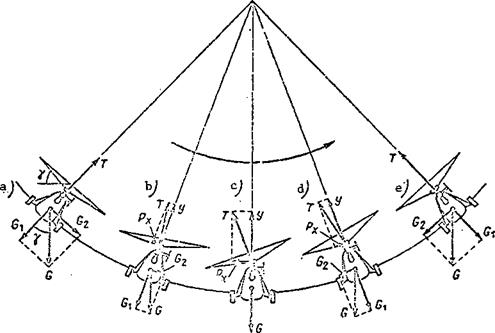Helicopter Dynamic Stability
General analysis of dynamic stability. While static stability defines the attitude stability, dynamic stability defines the nature of the helicopter motion after disruption of equilibrium. In equilibrium the helicopter travels in a straight line with constant velocity and without rotation. Such motion is called undisturbed. If equilibrium is disrupted, the helicopter rotates about its axes and the flight velocity and direction change. This motion is called disturbed. Disturbed motion may be either aperiodic or oscillatory.
Aperiodic motion is motion in one direction from the equilibrium position. For example, when equilibrium is disturbed the helicopter center of gravity deviates (Figure 101, solid line). After elimination of the factor causing disruption of the equilibrium, the nature of the disturbed motion may differ.
|
Figure 101. Dynamic stability. |
If the center of gravity approaches the line of unperturbed motion (Figure 101a, dashed line), the helicopter has aperiodic stability; if the
helicopter center of gravity continues to deviate further from the equilibrium line (Figure 101b) the helicopter has aperiodic instability. Oscillatory motion is periodic back-and-forth motion relative to the equilibrium line.
If after disruption of equilibrium the helicopter center of gravity travels along a wave-like curvilinear trajectory and this motion is damped, the helicopter has oscillatory dynamic stability (Figure 101c). If the amplitude of the disturbed oscillatory motion increases, the helicopter has dynamic instability or oscillatory instability (Figure lOld).
Most frequently the disturbed motion of the helicopter is oscillatory, and the oscillations will be complex, since the helicopter oscillates simultaneously about all axes. Moreover, the short and long periodic oscillations are superposed on one another. The short-period helicopter oscillations are those about the center of gravity with account for the influence of the main rotor damping moment; the long-period oscillations are those about a center located at a considerable distance from the helicopter.
Helicopter transverse oscillations in the hovering regime. Let us
assume that the helicopter banks to the angle у in the hovering regime (Figure
102 a). We resolve the helicopter weight force into the components:
acting in the plane of symmetry, and G2 perpendicular to this plane. The
force = G sin у is unbalanced and causes sideslip of the helicopter. As
a result of the increase of the sideslip velocity, the main rotor cone-of-
revolution axis will tilt to the side opposite the slip (Figure 102b). The
force Px is created, which reduces the sideslip velocity and the moment of this
force reduces the bank angle. But the force P is less than the force G„;
о x 2
therefore, the sidelsip velocity will increase and the velocity will be maximal at the moment the helicopter arrives at the position shown in Figure 102 c.
 The helicopter continues its motion in the same Then the force G2 changes from driving to retarding,
The helicopter continues its motion in the same Then the force G2 changes from driving to retarding,
|
![]() decreases. As a result, the tilt of the cone-of-revolution axis decreases and the moment of the force P^ about the longitudinal axis banks the helicopter in the opposite direction. When the helicopter reaches its maximal deviation (Figure 102e) further motion terminates. The cone-of-revolution axis coincides with the huh axis and the force P =0. But the force G
decreases. As a result, the tilt of the cone-of-revolution axis decreases and the moment of the force P^ about the longitudinal axis banks the helicopter in the opposite direction. When the helicopter reaches its maximal deviation (Figure 102e) further motion terminates. The cone-of-revolution axis coincides with the huh axis and the force P =0. But the force G
X /.
reaches a maximum and causes motion in the reverse direction and the whole cycle repeats. This transverse rocking of the helicopter will increase continuously, and the helicopter will turn over if these oscillations are not terminated in time.
We have examined in this example only the transverse oscillations, but in reality the transverse oscillations are supplemented by longitudinal and directional oscillations; therefore the pattern of the oscillatory motions will be more complex.
Longitudinal oscillations of helicopter in flight with horizontal velocity. If the longitudinal equilibrium of a helicopter is disturbed, longitudinal oscillations develop (Figure 103),i. e., the helicopter will travel along a wave-like trajectory. The existence of such oscillations is confirmed by flight tests in which automatic instruments record the nature of the helicopter oscillations about all axes. The longitudinal oscillations have a considerably longer period (total oscillation time) than the transverse oscillations. The amplitude of the longitudinal oscillations increases in the course of time, although more slowly than the amplitude of the transverse oscillations. Helicopter oscillations about the vertical axis also take place; however, they are performed with a period longer than the transverse oscillations but shorter than the longitudinal oscillations.
|
Figure 103. Helicopter longitudinal oscillations. |
From this analysis we can conclude that the helicopter has dynamic instability. Therefore, if the equilibrium of the helicopter is disturbed it will have an oscillatory motion with increasing amplitude and cannot by itself eliminate these oscillations. This means that in every case of equilibrium disruption the pilot must take measures to restore the equilibrium, i. e., he must control the helicopter.














